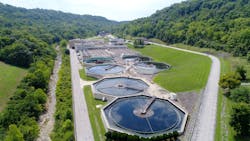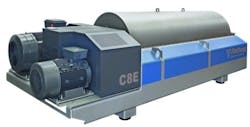Big in Business: Sewage Sludge Thickening
About the author:
Nils Engelke is public relations and communications manager for Flottweg Separation Technology. Engelke can be reached at [email protected].
When purifying industrial and/or municipal sewage, the challenge is to produce not only clean water at the end of the treatment process, but also a highly dewatered, compact sewage sludge with a high dry solids content.
The reduction in the amount of sludge associated with a high total dry solids content due to the separation of the watery portion permits the cost-effective, energy-saving further treatment of the sewage sludge, such as storage in depots, drying, burning or use in agriculture. A highly efficient sludge treatment also includes an optimal thickening of the sludge from the wastewater treatment before digestion and dewatering.
To make the thickening of sewage sludge as efficient as possible, it is important to decide on effective thickening equipment. Large sewage treatment plants, as well as many smaller and medium-sized plants rely on mechanical separation technology using decanter centrifuges.
Thickening Sewage Sludge with Decanter Centrifuges
The first stage of a sewage treatment plant is the mechanical wastewater treatment via rakes, grit traps, grease separators, etc. This produces pretreated water and a so-called preclarification sludge or primary sludge.
The pretreated water enters the biological purification section, where microorganisms absorb pollutants and convert them into endogenous substances. This decomposition process in the sewage treatment plant continually generates fine biological sludge. To ensure a stable decomposition process in the biological cleaning stage, part of this biological sludge is removed. The biological sludge removed is called the surplus sludge in the later phases of the process.
Primary sludge and surplus sludge are then brought together and enter the sludge treatment section.
This sludge typically contains 5 to 10 grams per liter of total dry solids and should normally be thickened to 5 to 8% before being pumped into the digestion tower. This process removes 90 to 95% of the water from the slurry.
Higher Gas Yield from Anaerobic Digestion
In a digester, an anaerobic digestion process converts organic mass into digestion gas, primarily methane. This gas generates energy to operate the sewage treatment plant. To make optimum use of the digestion space in the digester, it is necessary to thicken the surplus sludge. The result for the operators of sewage treatment plants is increased efficiency in the digestion process.
OSE decanters (OSE stands for the German phrase for “optimum sludge thickening”) smooth the feeding of the digester by using solid regulation in the thickened sludge. A set point of 6%, for example, can be maintained constant to ± 0.1%.
Such a decanter is specifically designed and adapted to the thickening of sludge. In addition to a constant thickened sludge concentration, its low polymer consumption of 1 to 2 grams per kilogram of dry solids relieves the burden of ongoing operating costs.
Since the desired sludge concentration is low in comparison with high-level dewatering, operators can get by with a low bowl speed. The result is a significant reduction in electrical power consumption. The power consumption of a Flottweg OSE decanter is reduced by focusing the design of the decanter on sludge thickening.
The automatic regulation of a decanter compensates for fluctuations in the sludge concentration. When compared with other systems for the thickening of sewage sludge, such as belt and disk thickeners or screw thickeners, there are some elements that may present advantages.
With an energy consumption of less than 0.2 kWh per cubit meter, specific structural design permits the energy consumption of decanters to be significantly reduced. Decanters can also reduce the need for flocculant, since operation is also possible without starch-based polymer flocculant (pFM). If pFM is used, then only a minimal dose — 0.5 to 2 kilograms per ton dry solids — is necessary.
Decanter centrifuges also continuously provide the ideal separation results due to the automatic and independent regulation of the bowl and differential speeds. As such, they also require minimum downtime, and centrifuges with easy-access design further improve on maintenance friendliness.
These systems also pose no health risk for system personnel because there is no aerosol pollution and no escaping contamination or odors due to the closed system.
Given the design details — such as deep pond and steep cone — they also have a larger sedimentation volume. This permits a high throughput density, and therefore the space requirement is low in comparison with the throughput performance.
During operation, the decanter does not need any water. Freshwater is only required for the preparation of the pFM. For occasional flushing — for example, before shutdown — service water is sufficient. This ensures minimal water is consumed during operation.
Lastly, the automatic operation requires no intervention of the personnel during normal operation of the decanter centrifuge.
Summary
The calculations on the next page show the decanter is more than just an alternative to mechanical sewage sludge thickening.
Even in smaller and medium sewage treatment plants, advantages such as low downtime, low flocculant consumption and large sedimentation volumes in less space can
be crucial.
Other bonuses, such as less odor and longer service life, only further the opportunities a decanter centrifuge can afford a utility. It can save the facility money while also reducing energy consumption. Weighing the costs and benefits of decanter centrifuges against other technology will provide a utility the best answer to their sludge thickening problems.


